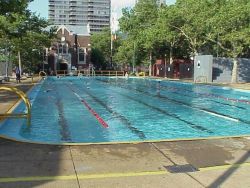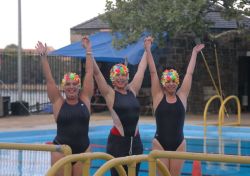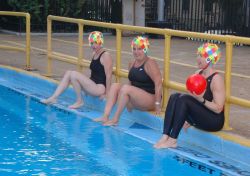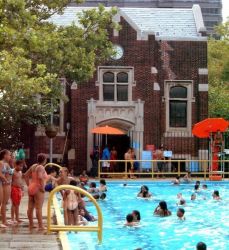John Jay Park
John Jay Park
What was here before?
In 1677 the provincial governor granted 46-acres here to Abraham Shotwell. Several generations and owners transformed Shotwell’s “Saw Kill Farm,” into an elegant country estate, similar to Gracie Mansion to the north. The estate was eventually bequeathed by the Delafield family to Trinity Church School, and the property sub-divided and sold off.
Land at the river’s edge was less expensive and supported a growing working-class community at the turn of the 20th century. The pace of development and residential influx east of the Second and Third Avenue elevated transit lines created a need for children’s healthful recreation. At the time, the bluff on the river retained a rural character before becoming parkland. To the south was a large, forested area known as Jones Wood considered for Manhattan’s premiere park before Central Park’s creation.
How did this site become a park?
In 1898, the City initiated condemnation of the rugged properties here for a park. The first parcel of land for the park was acquired in 1902 as part of the City and State’s 1887 Small Parks Act. The next year, a long-range park improvement plan was designed as the southern portion was graded, fences erected, and interim playground features installed. In 1906 a public bathhouse was built by the Manhattan Borough President.
Temporary playgrounds for toddlers and older children were built in 1910 as well as a baseball field. The easternmost block of East 77th Street, that cut the park’s south and north sections in two, was closed in 1912. A 40-foot swath of land was relinquished by the Parks Department to build Cherokee Place connecting to East 78th Street. In 1913 two permanent playgrounds opened, one for boys and one for girls. Many oriental plane trees provided shade for the 8,600 monthly visitors, and track competitions were held in the park, sponsored by the AAU Recreation Center Athletic League, as well as the public and parochial schools.
The English Gothic-styled recreation building of brick and limestone opened in 1914, and in addition to housing gymnasium equipment, its main floor was “arranged for use as a band stand in the summer months.” The inter-park baseball championship was described by the Parks Department as “the most successful tournament ever held in the history of the game.” A handball court was added in 1931.
A 1940 park plan shows basketball courts in the southwest quadrant along with an open play area designated for “roller and ice skating.” The swimming complex opened in stages between 1940 and 1942 as part of Works Progress Administration (WPA) capital construction program. The outdoor swimming pool opened in 1940 and measured 50 by 145 feet. In 1941 the bathhouse was remodeled and reopened with an auditorium, large recreation room, gym, and changing facility which could accommodate 1,002 male and 590 female bathers. Oversight of the center, managed by the Manhattan Borough President, was transferred to the Parks Department.
Over the decades the densely used park became a vital community hub, hosting dance festivals, concerts, travelling marionette theater, and children’s storytelling in addition to a variety of athletic tournaments. Tennis and racquetball courts were introduced in the south side of the park.
In 1985 the “Cherokee Place Sculpture Court” was landscaped by Thomas Balsley Associates with a seating area and walkway, where Douglass Abdell’s abstract Kryeti-Aekyad #2 and Eaphae-Aekyad #2 are displayed.
Who is this park named for?
John Jay Park is named for the New York jurist and statesman John Jay (1745-1829) who was elected President of the First Continental Congress in 1778. Jay drafted New York’s first constitution in 1777, was appointed Minister to Spain in 1779, and negotiated the peace treaty with England in 1783. With Hamilton and Madison he wrote The Federalist Papers (1787), which advocated the new Constitution. Jay then served as the first Chief Justice of the Supreme Court (1789-1795). In his last political position, he was elected for two consecutive terms as the Governor of New York (1795-1801).
Check out your park's Vital Signs
Clean & Safe
Green & Resilient
Empowered & Engaged Users
Share your feedback or learn more about how this park is part of a
Vital Park System
Contacts
Pool: (646) 660-3484








